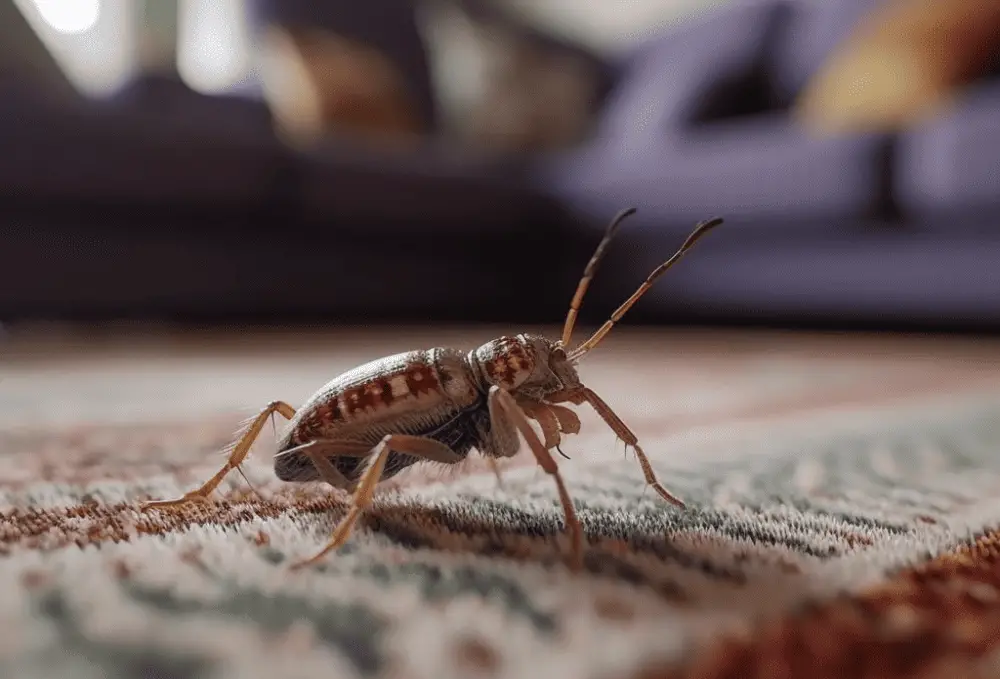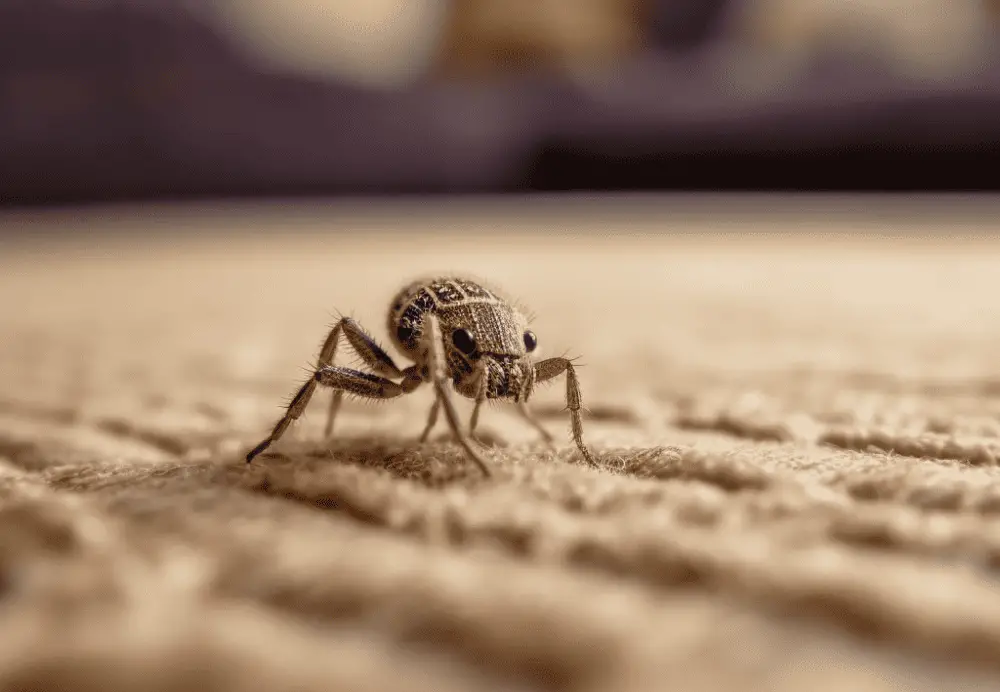Fleas can be a pesky problem for homeowners, especially those with pets. These tiny parasites are not only a nuisance to humans and animals, but they can also infest the home and establish a stronghold in carpets.
An important question that arises when dealing with flea infestations is how long do fleas live on carpet?
Carpets provide an ideal environment for fleas to thrive, as they offer warmth, protection, and a steady source of food from pet or human inhabitants. Typically, adult fleas can live anywhere from a few weeks to several months in a carpeted environment.
Fleas and Their Life Cycle
Fleas are small, wingless insects that infest and feed on the blood of mammals and birds. They thrive in various environments, including carpets.
Adult Fleas
Adult fleas are the most visible stage of the life cycle, which can normally last from two weeks to several months.
Their lifespan largely depends on the availability of hosts, temperature, and humidity. Adult fleas are great jumpers, enabling them to move between hosts.
- Temperature: Fleas thrive in temperatures between 70°F (21°C) and 85°F (29°C).
- Humidity: A humidity level of 70% to 85% is ideal for fleas to flourish.
In unfavorable conditions, adult fleas can survive for just a few days—or even a week—without a blood meal.
Flea Larvae
Flea larvae are the next stage in the life cycle after eggs.
They are small, typically around 3-4 mm in length, and cream-colored. Flea larvae prefer dark, hidden spaces such as cracks, crevices, and carpet fibers. They feed primarily on organic debris, including the feces of adult fleas.
- Duration: The larval stage lasts between 5 and 20 days.
Larvae are vulnerable to environmental factors like heat and dryness, so controlling these factors in the home can help prevent an infestation.
Female Flea
Female fleas play a vital role in the life cycle due to their ability to lay eggs.
After a blood meal from a host, the female flea can lay up to 50 eggs per day, contributing to a rapid increase in the flea population. These eggs then fall from the host onto the environment, including carpets.
- Egg-laying: Female fleas can lay 2,000 or more eggs in their lifetime.
Effectively targeting female fleas to prevent reproduction is a key factor in controlling flea infestations. This can be accomplished through various methods, such as using insect growth regulators, which disrupt the flea’s reproductive cycle.
Factors Impacting Flea Life on Carpet

Environment
The environment plays a significant role in determining how long fleas can survive on carpets.
Fleas prefer to live in warmer and more humid conditions where they can easily reproduce. In cooler temperatures, flea eggs, larvae, and pupae development slows down, extending the time it takes for them to reach adulthood.
Ideal temperatures range between 70-85°F (21-29°C), and relative humidity around 70%.
Food Source
Adult fleas typically feed on the blood of their host animal, such as pets or humans. If there is a host nearby, fleas can easily acquire their meals and survive longer.
The lack of a host, however, limits their food source and can lead to a shortened lifespan. Keep in mind that adult fleas can live for several months without a meal.
Water
Fleas require moisture to sustain their life cycle, particularly during the egg and larval stages. When it comes to flea survival, dry environments can be detrimental.
In arid conditions, flea eggs can become dehydrated and eventually die, while larvae would be unable to grow.
Conditions
The overall condition of the carpet can also impact the ability of fleas to thrive. For example:
- Cleanliness: Regularly cleaning carpets through vacuuming or steam cleaning will help remove flea eggs and larvae. Fleas are less likely to survive in well-maintained environments.
- Carpet type: Fleas can hide and lay their eggs deep within the fibers of some carpets, making it difficult to dislodge them. Thicker carpets provide more hiding places for fleas compared to thinner ones.
Preventing and Treating Flea Infestations
Keeping Your House Clean
One of the most effective ways to prevent and treat flea infestations is by keeping your house clean.
Regularly vacuuming carpets, rugs, and upholstery helps remove adult fleas, eggs, and larvae from your home’s surfaces. This also includes washing your pet’s bedding, toys, and living spaces frequently.
The cleaner your house is, the harder it will be for fleas to thrive.
Using Pest Control Methods
Alongside cleanliness, employing various pest control methods is crucial to prevent and treat flea infestations.
Some common and effective methods include:
- Insect Growth Regulators (IGRs): These are chemical substances that hinder fleas’ growth and reproduction. They can be applied in the form of sprays or foggers and are effective at breaking the flea’s life cycle.
- Chemical Treatments: Pesticides such as insecticide sprays or powders can be used to target specific areas where fleas are more likely to reside. Make sure to follow the product’s instructions carefully and keep your pets away from treated areas until they are safe to return.
- Natural Methods: Some natural alternatives for controlling fleas include using diatomaceous earth, boric acid, or essential oils like lavender, eucalyptus, and peppermint. These methods can help deter fleas and limit their numbers while being safer for your pets and the environment.
Fleas and Their Effects on Humans and Animals
Fleas are small, wingless insects that infest and feed on the blood of animals and humans.
Diseases Transmitted by Fleas
Fleas are not only a nuisance, but they can also transmit diseases to their hosts.
Some of the diseases transmitted by fleas include:
- Bubonic Plague: This historical disease, also known as the Black Death, is transmitted by the bite of an infected flea. Although rare, it can still occur in some parts of the world, and it can be fatal if not treated with antibiotics.
- Murine Typhus: A bacterial infection transmitted by fleas found on rats, it can cause symptoms like fever, headache, and muscle aches. Treatment includes the use of antibiotics.
- Tungiasis: This is caused by the burrowing flea, which embeds itself into the skin, leading to serious infections and inflammation. Treatment may include removal of the flea and antibiotics.
Fleas in Animal Hosts
Fleas commonly infest animals like dogs, cats, birds, and rodents.
They can cause a range of problems for their hosts, including:
- Skin irritation: Flea bites cause itching and scratching, which can lead to open sores and infections if not treated.
- Allergic reactions: Some animals are allergic to flea saliva, which causes more severe itching and skin irritation, leading to hair loss and scabs.
- Anemia: In severe infestations, fleas can consume enough blood to cause anemia, especially in young or small animals. This can be life-threatening if not addressed promptly.
- Tapeworm infection: Fleas can transmit tapeworms to animals if they swallow an infected flea while grooming. Tapeworms can cause weight loss, digestive issues, and other health problems.
Protecting Your Furniture from Fleas
Fleas can be a real nuisance, especially when they start infesting your furniture.
In order to keep these pesky pests at bay, there are two main strategies to consider: regular cleaning and professional pest control for furniture.
Regular Cleaning
Vacuuming your furniture at least once a week can help remove flea eggs, larvae, and adult fleas.
Pay special attention to any cushions, nooks, and crannies where fleas may be hiding.
In addition to vacuuming, you should also:
- Wash slipcovers, cushions, and pet bedding in hot water to kill fleas at all stages of their life cycle
- Use a lint roller or sticky tape to pick up any flea eggs or adult fleas that may be clinging to fabric surfaces
- Sprinkle diatomaceous earth, a natural flea killer, on your upholstery and rugs, then vacuum it up after a few hours
Pest Control for Furniture
Pest control experts can treat your furniture with safe and effective flea control methods such as:
- Insect growth regulators (IGRs) that interrupt the flea life cycle
- Non-toxic sprays or powders that can kill adult fleas and their eggs
- Steam cleaning or hot water extraction can effectively exterminate fleas and their eggs
Remember, protecting your furniture from fleas requires a consistent and proactive approach.
By combining regular cleaning and pest control, you can keep these unwanted pests at bay and maintain a comfortable, flea-free environment for you and your loved ones.


